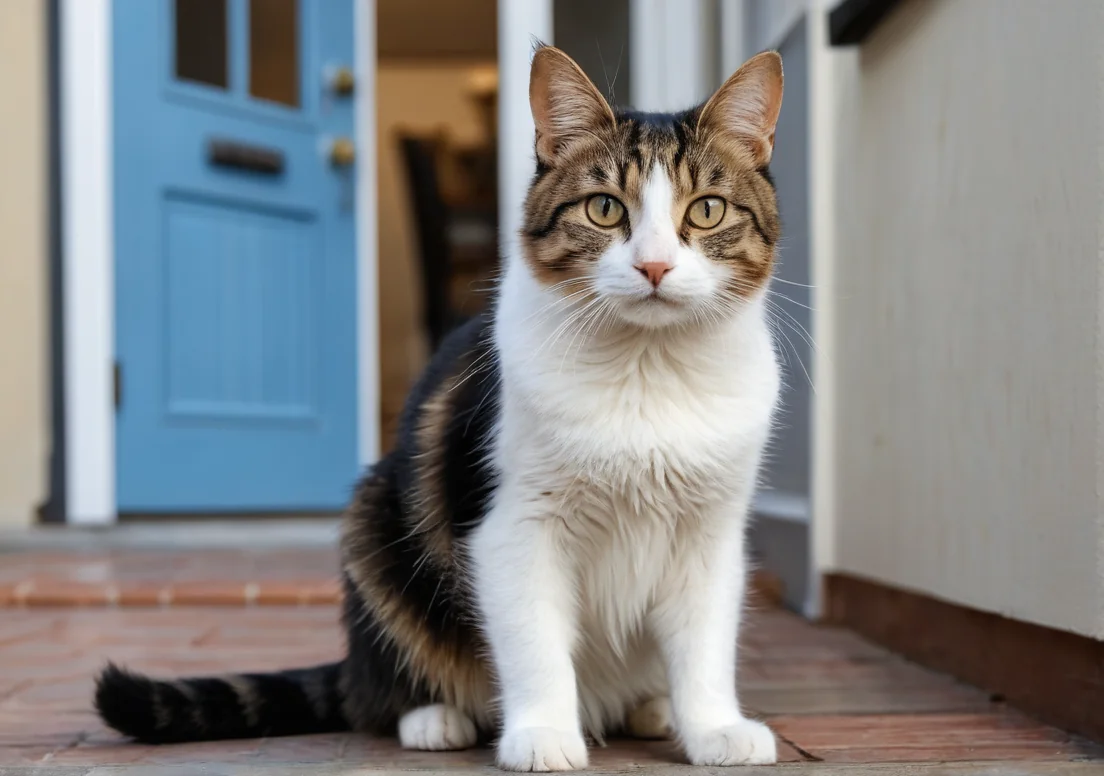Have you noticed a stray cat showing up at your house more often than not? It might seem like a simple case of feline curiosity, but there are a few surprising reasons behind this behavior.
Stray cats are drawn to your home for shelter, food, or the desire for companionship. They often see your space as a safe haven from the outside world, especially if they’ve had a difficult life on the street. The intrigue doesn’t end here; many layers to this story may leave you wondering more about this furry visitor. Keep reading to uncover the hidden motivations behind this unexpected friendship with your resident feline!

Seeking Food Sources
Stray cats have a keen instinct for survival, and food is a major draw to your home. If they’ve figured out that your place is a reliable source of sustenance, you can bet they’ll be back. This could stem from anything, like an intentionally placed food bowl or even accidental leftovers that’ve found their way outside.
If you’ve noticed the cat lingering around, it might just be sniffing out some tidbits from last night’s barbecue or from your kids’ outdoor snacks. Cats are particularly adept at scavenging, so even the tiniest crumb or scraps could keep them coming back for more.
Tip: If you aren’t looking to feed the stray, consider keeping trash lids secure and clean up any leftovers after outdoor meals.
Looking for Shelter
Stray cats seek out safe spaces just like any other animal. If your home provides comfort—a cozy porch, a sheltered garage, or even a warm yard during cold months—then it might just be the haven this cat is after.
Cats are naturally wary and may navigate urban settings by looking for spots that feel secure. Your house could be a refuge against harsh weather, predators, or even other aggressive animals. They often gravitate toward places where they feel sheltered from the elements but also from prying eyes.
In fact, the type of shelter they seek can vary widely, and they might even choose your space based on its quietness and hidden spots, making them feel safe. If you’ve got structures that allow for hiding—like shrubs, fences, or even a barn—these can all act as enticing shelter options for them.
Providing a secure environment for a stray can be beneficial not just for the cat but also for the neighborhood by reducing the likelihood of the cat roaming into traffic or congested areas in search of safety.
Socializing Needs
Stray cats often seek out human interaction because they crave some kind of companionship. If a stray cat keeps showing up at your home, it’s possible it’s searching for a friendly face. Many of these felines have had past experiences with people—some may have been abandoned or simply grew up around humans and became accustomed to our presence.
If you notice this cat approaching you or lingering around, it’s a sign it might be looking to socialize. Offering some gentle attention can make a huge difference. Try sitting quietly nearby or softly speaking to it. In some cases, coaxing it with a bit of food might help build that bond. Regular interactions not only provide the socialization the cat needs but can also help build your trust with it over time.
Territorial Behavior
Cats are inherently territorial animals, and your home might seem like a prime location for them. If a stray cat keeps returning, it may see your yard or porch as a safe haven. Cats typically establish and defend territories based on resources like food, shelter, and, of course, safety.
If it’s found a cozy spot in your yard or often sees you interacting with it, it might simply consider that place as part of its territorial claim. You may notice that the cat is more active when other animals are nearby—this could be its instinct to assert its territory. If you find it making itself comfortable, like lying on your porch or rubbing against your furniture, that’s a clear indication it’s claiming your space as part of its own.
To better understand this behavior, take note of the things that attract it: Are there welcoming structures, like dense bushes or warm spaces to curl up? Maybe there’s an opportunity for shelter, especially during inclement weather. Being aware of how your environment is perceived by the cat can help you decide how to handle its visits—whether to let it be or, alternatively, to guide it toward a more appropriate place.
Health Issues
A stray cat might be drawn to your home due to health problems such as injuries or illness. Cats living outdoors often struggle with issues like flea infestations, tics, or even respiratory infections. If they’re feeling under the weather, they’ll seek a safe place to recover. Some might even have untreated wounds from fights with other animals. If you notice the cat spending a lot of time at your house, consider providing them with food and water, alongside offering shelter. Keeping an eye out for any visible signs like limping or unusual behavior can help. If you really feel for the kitty, reaching out to a local animal shelter or vet could guide you on how to assist them effectively.
Seasonal Changes
As temperatures drop or storms approach, strays instinctively look for warmth and shelter. Seasonal changes can significantly impact a stray cat’s behavior, often leading them to knock on your door—or at least appear at your porch. In colder months, they might be searching for a cozy spot to escape the chill, while in summer, they may be seeking shade or water. It’s not just about comfort; drastic weather can also affect their food sources, prompting them to explore new territories in search of sustenance.
If you’re concerned about their well-being, consider creating a small, sheltered area in your yard with straw for insulation, ensuring it’s safe and out of the elements. You could also provide a bowl of fresh water, especially during the hot summer months when hydration is crucial. Additionally, keeping an eye on your local wildlife can help you understand the cat’s potential hunting grounds and food availability.
Cat Communication Patterns
Stray cats often make their rounds based on their communication signals, which can be surprisingly subtle yet telling. If a stray cat keeps showing up at your door, it might be expressing specific needs or desires. One common conveyance is body language—like a raised tail or slow blinks—that indicates comfort and trust.
Another major aspect is vocalization. If you hear a cat meowing more than usual, it could be trying to get your attention, signal hunger, or express affection. Strays may also rub against your house or furniture, marking territory and seeking a safe spot.
Understanding these signals can help you assess what this feline neighbor might need. Maybe it’s looking for food, shelter, or a safe space away from potential dangers. Cats are creatures of habit, so if they find a cozy spot at your place, they might return often, hoping to establish a routine with you.
Interesting Stray Cat Facts
Stray cats are more than just the neighborhood shadows; they play a significant role in both botanical and animal communities. Here are some intriguing facts about these resilient creatures:
Population Impact : In the U.S., it’s estimated that there are around 60 million unowned cats. They help control rodent populations, playing an informal role in ecosystem balance.
Social Dynamics : Stray cats often form colonies, and social bonds can lead them to congregate around reliable resources, including your home if you’ve established a feeding routine.
Survival Skills : They’re incredibly resourceful. Many survive by scavenging but also develop hunting skills, adapting their diets based on what’s available.
Health Conditions : Stray cats are at risk for various health issues, including parasites and diseases. If a new cat keeps visiting, it’s essential to consider its health for your pets’ safety.
Spay and Neuter : Efforts to manage stray populations largely depend on spay and neuter programs. Supporting local initiatives can significantly impact this issue.
Understanding these behaviors and facts can enrich your interactions with the stray cat in your life, whether you’re considering offering it a permanent home or just a little kindness.
What to Do If You Want to Help
Seeing a stray cat keep coming by your place can tug at your heartstrings. If you’re feeling compelled to lend a hand, there are a few thoughtful steps you can take to make a positive impact on the cat’s life.
Start with food. Offer a consistent source of nourishment. You can buy high-quality dry cat food or wet food, as strays often appreciate the moisture in canned food. Setting out a small bowl daily at the same time helps the cat recognize it as a reliable food source.
Keep it clean. Ensure the feeding area stays tidy by refreshing the food and water. Cats can be finicky about cleanliness, and a messy spot might deter them from returning.
Consider shelter options. If the weather’s harsh, providing a safe space is vital. An outdoor cat shelter can be as simple as a sturdy cardboard box lined with straw, placed in a protected area. You can also look for pre-made shelters online or at local shelters, providing a cozy refuge from the elements.
Think about veterinary care. When it’s safe and if the cat trusts you, consider trapping the cat (using a humane trap) for spaying or neutering. Many shelters offer assistance with this, often at a reduced cost. This helps control the stray population and promotes better health for the cat.
Check for identification. If the stray seems friendly and you can approach it, look for a collar or ID tag. If it has one, try to contact the owner before deciding to take further action.
Connect with local rescues. If you’re overwhelmed, reach out to a local animal rescue group. They often have resources to help with food, shelter options, and veterinary services, as well as advice tailored to your specific situation.
Unique Insight: Keep a diary of the cat’s visits. Tracking when the cat appears, its behavior, and any identifying characteristics can provide valuable information if you decide to contact a shelter or rescue. This can also help you identify if it’s the same cat over time or different strays, making your efforts more efficient.
Being mindful of the stray cat’s needs and taking small, consistent steps can foster a better environment for it, benefiting both the cat and your community.
Alex, a passionate animal lover, has experience in training and understanding animal behavior. As a proud pet parent to two dogs and three cats, he founded AnimalReport.net to share insights from animal experts and expand his knowledge of the animal kingdom.




